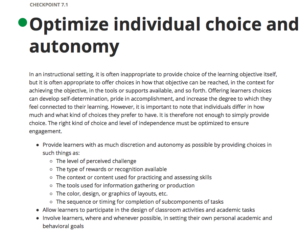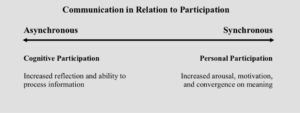Category: Digital Porfolio
Hello and welcome to my new and improved Topic 3 blog post! Before you begin reading, please watch my brief description to get a sense of how I dove further into this topic and gained more insight about equitable learning for all K-12 students.
I had trouble finding a way to make it clear what parts of my blog have been edited and revamped but in the end I decided to BOLD my changes. Additionally, I have added hyperlinks to outside resources that helped me complete this blog. Here we go:
How can you ensure equitable access to authentic, meaningful & relevant learning environments for all learners in K-12 open and distributed learning contexts? What did you already know, what do you know now based on the course readings and activities, what do you hope to learn?
If students all learn differently, shouldn't we give them a choice in how they represent this learning?
Here's 1st iteration of my Show What You Know choice board made for Ts & Ss. Stay tuned for links to innovation tutorialshttps://t.co/JGjkfsaWzf #distancelearning #TsGiveTs pic.twitter.com/mPwZX79VY4
— Make💡Design💡Innovate (@christinekdixon) July 21, 2020
I found this visual provocation on Twitter the other day and it inspired me to dive into Topic 3-Equity and Access in Distributed and Online Learning Environments. How great is this visual for both teachers and students? There is a great variety of digital tools listed that are easily accessible to all students. I love that there are also options that do not require wifi or a device; this ensures all students can participate without worrying about digital access issues.
After reading Basham et al. (2020) speak about the diversity of our learners and how we can help them best succeed in this environment I was able to see how the Universal Design for Learning(UDL) framework is an extremely important resource for all educators teaching in distributed classrooms, and in physical classrooms as well. UDL provides a framework that encourages Multiple Means of Engagement, Action and Representation (Basham et al., p. 483).
Here is an example of a UDL Checkpoint that encourages voice and choice:

Research shows that students perform better and are happier when they are provided with voice and choice.
I found a handful of educators that are advocates for providing students with voice and choice for all students:
The one and only Shelley Moore
Twitter is filled with educators that are advocating for what they are most passionate about. It can be overwhelming at first, but by using specific hashtags and following along Twitter threads you can easily find educators that align with your personal pedagogy.
I have never heard of Kral and Schrab’s 8 design principles until today but they really made me think about how I will set up my future classroom. The Design Principles are as follows:
“Design Principle 1: A space young people control
Design Principle 2: A space for hanging out and ‘mucking around’
Design Principle 3: A space where learners learn
Design Principle 4: A space to grow into new roles and responsibilities
Design Principle 5: A space to practice oral and written language
Design Principle 6: A space to express self and cultural identity through multimodal forms
Design Principle 7: A space to develop and engage in enterprise
Design Principle 8: A space to engage with the world” (Kral & Schrab, 2012, p. 58).
Design Principle 1 made me think about online classroom blogs, or assignments that require students to learn from each other, rather than learning from the teacher. Online classrooms provide an array of activities that young people can control!
Design Principle 5 is another example that can be easily implemented in a blended learning setting. Personally, I used to think that online learning only allowed opportunities for students to practice their written language. However, there are many tools and programs that students can use to practice oral language online as well; ultimately, this also contributes to creating equitable learning environments where all students can succeed.
Kate prompted me to share more about how I think these Design Principles could be implemented into the classroom. To start, Design Principle 2 could be implemented into a classroom by providing opportunities for trial and error. Students learn better, and have more fun, when they can experiment and play around until they figure it out for themselves so as educators we must encourage them to learn through play!
Selwyn(2020) spoke about the effects that the COVID-19 pandemic and how it has affected students; he refers to this online learning as “emergency measures” (para. 5). It is no surprise that many businesses and online programs have been working hard to meet the needs of our schools; however, I was surprised to learn that it has created a type of pandemic education race to see who can create the most effective tools. The article progresses to speak about access issues that have accompanied COVID-19 and I can totally relate. For example, I have been participating in #edci339 while my Mom has also been working from home and joining Zoom calls all day. Luckily, we have our own laptops but we constantly run into internet issues with both of us using so much for our video calls. This has given me a new appreciation for the importance of asynchronous learning. If I ever get the chance to teach in a distributed classroom I will ensure to always offer an asynchronous option as well as a synchronous option so that all students have the chance to join in. Even something as simple as when Verena videotaped the Zoom meeting with the guest speakers could be beneficial to students who do not always have access to the internet because then they can watch it on their own time but still be a part of the community. Students usually share their devices with siblings and parents and will run into similar issues that my Mom and I did. Luckily, through this blog post and through my choice board activities I have gained a great sense of empathy towards accessibility issues. This will help me provide my students with meaningful experiences through distributed learning.
Asynchronous and synchronous learning environments are a hot topic right now! What one is better for our students as we approach September and the potential to revert back to online distance learning due to COVID-19? Through my research and readings, I have learned there is no right answer; students need a balance.

These screenshots were retrieved from: https://oit.utk.edu/wp-content/uploads/handout_synch_asynch.pdf

Ultimately, our students are so diverse and we need to provide them with learning oppurtunities that work for them. By following the UDL Guidelines that suggest providing Multiple Means of Engagement, Action and Representation we are able to personalize and differentiate learning. When it comes to a Distributed learning setting, teachers have the option to use synchronous and asynchronous communications. Teachers need to be mindful of students’ abilities and accessibility situations in order to create class plans (or backup options) so everyone can join in.
References
Basham, J.D., Blackorby, J., Stahl, S. & Zhang, L. (2018) Universal Design for Learning Because Students are (the) Variable. In R. Ferdig & K. Kennedy (Eds.), Handbook of research on K-12 online and blended learning (pp. 477-507). Pittsburgh, PA: Carnegie Mellon University ETC Press.
CAST (2018). Optimize Individual Choice and Autonomy. Universal Design for Learning Guidelines version 2.2. Retrieved from http://udlguidelines.cast.org/engagement/recruiting-interest/choice-autonomy
Kral, I. & Schwab, R.G. (2012). Chapter 4: Design Principles for Indigenous Learning Spaces. Safe Learning Spaces. Youth, Literacy and New Media in Remote Indigenous Australia. ANU Press. http://doi.org/10.22459/LS.08.2012 Retrieved from: http://press-files.anu.edu.au/downloads/press/p197731/pdf/ch041.pdf
Office of Information Technology. (n.d).When, why, and how to use synchronous vs. asynchronous communication. Office of Information Technology. Retrieved from: https://oit.utk.edu/wp-content/uploads/handout_synch_asynch.pdf
Selwyn. N. (2020). Online learning: Rethinking teachers’ ‘digital competence’ in light of COVID-19.[Weblog]. Retrieved from: https://lens.monash.edu/@education/2020/04/30/1380217/online-learning-rethinking-teachers-digital-competence-in-light-
I was excited to see this as an optional activity for this week because I love Shelley Moore but I have not yet had a chance to participate in her online book club that I have heard so much about. I chose to complete this for Topic 3’s optional activity because it is so important to gain experience with new resources before you implement them into your own classroom. Additionally, as a full time worker and part time summer student, I needed an outlet for myself and the book club has acted like a “brain break” for me because it was so fun! I have been following her on Instagram from my personal account for a while and it made me think about starting an educator Instagram page to connect to even more educators. This made me curious about what other educators think about using Instagram as PLN. Is it comparable to Twitter? I love following other teachers because I am such a visual learner that the videos and photos they constantly post are inspiring!
I am currently working full time as a summer camp instructor so I was excited to discover that Shelley posts all of the previous book club episodes on her youtube channel. Here is the link to episode 1 of reading “Potlatch as Pedagogy”, which was written by Sara and Robert Davidson. Although I wasn’t able to participate in the live chats and interactions, I was able to make it work and gain a lot from this experience. I connected this to the importance of synchronous vs. asynchronous learning; ultimately, I find that I learn better in synchronous settings because it holds me more accountable and I can ask questions to get an immediate response. With that being said, asynchronous learning environments can also be beneficial when you are self-determined and willing to put in the work. This was a busy work week so having the option to listen to the videos whenever I have my own free time really helped me succeed through this activity! What a great chance for me to step into the shoes of my future students.
I have created a 5MM Bookclub Mind Map to showcase my experiences which will help me empathize with my students one day.
Ultimately, my experience following allowing with Shelley Moore’s book club connects to the #edci339 course outcomes number 4 and 6. This provided me with practical experience in an open learning setting. Even though I was not able to participate in the live chats I gained a lot from the asynchronous learning environment which goes to show the importance of providing options to ensure equitable access for all. The more I am able to put myself into the shoes of my future learners the better teacher I will be; empathy and patience are crucial traits for a teacher in an online setting.I know that my experience with the online book club has inspired me to implement this in my class and it has also provided me with confidence because now I know what it is like!
This week I went totally out of my comfort zone and chose to create a Twitter account to begin building my Professional Learning Network (PLN). I started off with making an introduction tweet just so I could figure out how the program worked and I was shocked at the response I got! Verena liked and retweeted post, but I also got a couple of likes from educators in Alberta. This encouraged me to go check out their Twitter profiles and from there I found even more educators that I was inspired to follow. I will be the first to admit that I never thought I would enjoy using Twitter, and until this course I had always neglected to make an account just because I was a little nervous and unsure of the program’s offerings.
I am excited to join the twitter community as I work towards becoming a future educator! I can't wait to expand my knowledge towards open and distributed learning with @verenanz and my peers #edci339
— Miss Heemskerk (@CarlyHeemskerk) July 15, 2020
I am still working through all of Twitter’s features but I was able to spend time “lurking” through the #edci339 feed. I quickly realized that many of me peers made their accounts last week so it has been fun interacting with their ideas regarding building relationships in open learning spaces; I have been able to expand my learning even further by looking at the content my classmates are sharing.
Ultimately, I connected my experience creating my PLN to the course outcomes number 2 and number 6. Twitter is a great chance for me to interact with the current literature regarding open learning and I love that it is presented in unique ways such as infographics, videos or articles. Additionally, Twitter is providing me with practical experience using Twitter as both an educator and a student. I believe both of these learning outcomes are crucial as we learn about distributed and open learning because you cannot truly understand the topic if you do not immerse yourself in it!
I found this when I was reading through Shelley Moore’s posts and it made me smile…I hope it brightens up your day too 🙂
https://twitter.com/ashy_kneez/status/1281027998330675201
For the first component of my digital portfolio, I chose to attend Dr. Barb Brown’s lecture on building relationships in online classroom settings. I created a mind map to demonstrate my learning and highlight some of the main ideas that resonated with me.

I chose to participate in this online lecture because I am passionate about student-teacher relationships and hum-centred learning. Luckily, I was able to join in despite by busy schedule! I loved listening to Barb speak because she seemed genuinely invested in sharing all of her knowledge with us. It takes a certain type of person to be a teacher, especially an online teacher! I can think of a variety of in-person ice breaker games to play with my students and after listening to Barb I have been trying to think of how these could be completed online. For example, instead of doing a BINGO sheet to introduce yourself to your classmates, you could play two truths and a lie over Zoom or over Padlet! Not only do teachers need to be invested in creating relationships, but they need to be creative and easily adaptable.
The most important thing I learned was that online learning is always evolving. I connected this to the first learning outcome from the #edci339 course syllabus; I gained an appreciation for human-centred learning online and I left feeling inspired about new ways to personalize online learning for my future students!
I have created three goals for myself when I become a teacher to ensure that I am supporting human-centred learning where students are given voice and choice and where they are having FUN!
- Check in with students and their families at least once a week – How are things going? What can I do to help you best suceed?
- Provide OPTIONS – give students a variety of choices when completing a project and encourage them to get creative!
- Allow students to teach students – encourage think-pair-share chances, partner projects and other collaborative activities. Open learning environments provide a great platform for this but it is up to to the teacher to create appropriate lessons!
